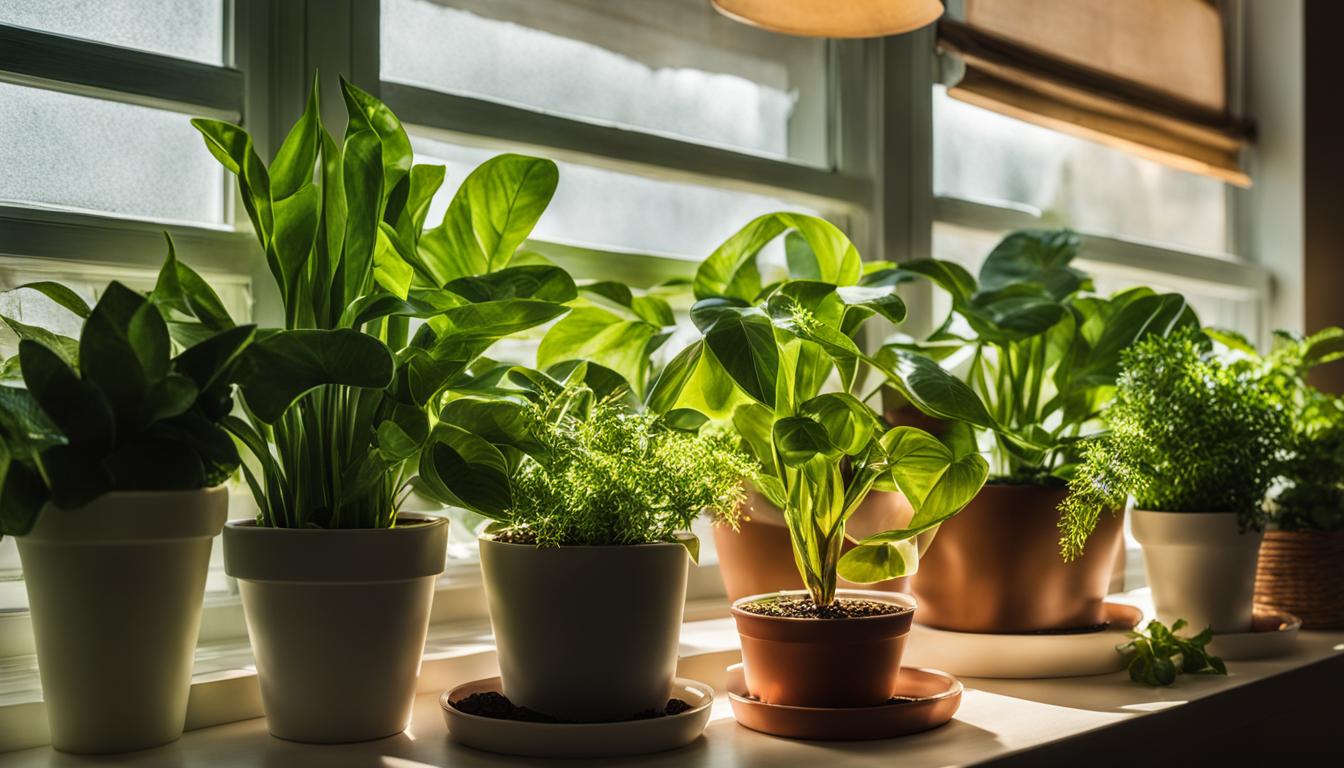
Providing the right lighting is crucial for the health and growth of indoor plants. Without sufficient light, plants cannot carry out photosynthesis effectively, leading to poor growth, yellowing leaves, and even death.
In this article, I will explore the different types of lighting options for indoor plants and how to choose the best one for your specific plant species.
Key Takeaways:
- Choosing the right lighting is essential for the health and growth of indoor plants.
- LED lights are highly efficient and provide a full spectrum of lighting.
- Consider the specific light requirements of your plants to choose the best type of light.
- The intensity and distance of the light source are important factors to consider.
- Supplementing natural light with artificial lighting can ensure adequate light for your indoor plants.
Understanding the Different Types of Indoor Plant Lights
When it comes to providing the optimal lighting for indoor plants, it’s important to understand the different types of lights available. Each type has its own characteristics and benefits, so choosing the right one for your plants is essential for their growth and well-being.
LED Lights
LED lights are a popular choice for indoor plant lighting due to their energy efficiency and full spectrum of light. They are highly efficient and can be programmed to adjust the intensity, providing the perfect lighting conditions for your plants. LED lights can also be synchronized with smart devices, allowing you to control and monitor the lighting remotely.
Incandescent Lights
Incandescent lights are suitable for low-light houseplants but should be avoided for light-loving plants due to their high heat output. They emit a warm, yellow light, which can be beneficial for certain plants. However, they are not as energy-efficient as other options and may need to be positioned further away from the plants to prevent overheating.
Fluorescent Lights
Fluorescent lights are a popular choice for indoor plants with low to medium light requirements. They are available in various sizes and spectrums, with T5 systems offering more intense light. Compact fluorescent lights are a more cost-effective option, providing adequate lighting for indoor houseplants.
Halides
Halides are commonly used in larger spaces or on larger plants. They emit intense light, making them suitable for plants with high light requirements. However, they can be more expensive and may require additional cooling systems to manage the heat they generate.
Understanding the different types of indoor plant lights will help you choose the best one for your specific plant species. Consider the light requirements of your plants and the benefits of each type before making a decision. By providing the right lighting, you can ensure healthy growth and vibrant indoor plants.
How to Choose the Right Light for Your Indoor Plants
When it comes to providing the optimal lighting for your indoor plants, there are several factors to consider. From light intensity to color spectrum, choosing the right light for your plants can make a significant difference in their growth and overall health. Here are some tips on how to choose the best light for your indoor plants:
1. Consider the Light Requirements of Your Plants
Each plant species has unique light requirements. Some plants thrive in low-light conditions, while others require bright, direct light. Before selecting a light for your indoor plants, research their specific light needs. This information will guide you in choosing a light that meets their requirements and promotes healthy growth.
2. Evaluate the Light Intensity
Light intensity refers to the brightness of the light emitted by a bulb. Different plants have varying light intensity needs. Low-light plants can thrive in dimmer conditions, while high-light plants require more intense light. Consider the light intensity recommended for your plants and choose a bulb that matches their needs.
3. Look for Full Spectrum Lights
Plants need various colors of light for different stages of growth. Look for lights that provide a full spectrum of colors, including violet-blue for vegetative growth and red for flowering. Full spectrum lights mimic natural sunlight and provide your plants with the necessary light they need for all stages of growth.
4. Opt for Energy-Efficient Options
Energy efficiency is an important consideration when choosing a light for your indoor plants. LED lights are highly recommended for their energy-saving capabilities and long lifespan. They are also customizable, allowing you to adjust the intensity and duration of light exposure to meet your plants’ needs.
5. Consider the Size and Placement
Take into account the size of your indoor space and the placement of your plants when choosing the right light. Ensure that the light covers the entire plant canopy and is positioned at the appropriate distance from the plants. This will ensure even light distribution and promote healthy growth.
| Plant Type | Light Requirements | Recommended Light Type |
|---|---|---|
| Snake Plant | Low to medium light | Fluorescent or LED lights |
| Rubber Plant | Moderate light | LED lights |
| Hibiscus | Bright, direct light | High-intensity LED lights |
By considering the specific light requirements of your indoor plants and following these guidelines, you can choose the right light that will provide optimal conditions for their growth. Remember to regularly monitor and adjust the lighting to ensure your plants receive adequate light for photosynthesis and overall health.
Understanding Light Intensity and Distance for Indoor Plants
When it comes to providing optimal lighting for indoor plants, understanding light intensity and distance is essential. Different plants have varying light requirements, and ensuring they receive the right amount of light is crucial for their growth and overall health.
Light intensity refers to the level of brightness that a plant receives. It is measured in foot-candles or lux. Generally, plants that require high light intensity should be placed closer to the light source, while those with lower light requirements can be positioned further away.
The distance between the light source and the plants also plays a significant role. If the light source is too far, plants may not receive enough light, leading to stretching or weak growth. On the other hand, if the light source is too close, it can cause damage to the leaves or create excessive heat, especially with high-intensity lights.
To determine the appropriate light intensity and distance for your indoor plants, consider their specific light requirements. Here’s a general guideline:
Light Intensity and Distance Guidelines for Indoor Plants
| Plant Type | Light Intensity | Distance from Light Source |
|---|---|---|
| Seedlings | Medium to High | 4-6 inches |
| Hydroponic Lettuce and Herbs | Medium to High | 6-12 inches |
| Foliage Houseplants | Low to Medium | 12-24 inches |
| Flowering Houseplants | Medium to High | 6-12 inches |
It’s important to note that these guidelines are general recommendations, and individual plant species may have specific requirements. Monitor your plants closely and make adjustments as needed to ensure they are receiving the optimal light intensity and distance for their growth.
Supplementing Natural Light with Artificial Lighting
When it comes to providing optimal lighting for indoor plants, sometimes natural light alone may not be sufficient. In such cases, supplementing natural light with artificial lighting can ensure that your plants receive the light they need to thrive. Artificial lights can compensate for a lack of sunlight and provide the necessary light spectrum for photosynthesis.
One of the best options for artificial lighting is LED grow lights. LED lights are highly energy-efficient, making them cost-effective in the long run. They also have the ability to mimic natural sunlight, providing a full spectrum of light that is essential for plant growth.
With LED grow lights, you can customize the intensity and duration of light exposure to meet the specific needs of your plants. Additionally, LED lights produce less heat compared to other types of lighting, reducing the risk of heat damage to your plants.
Another option for supplementing natural light is fluorescent lights, such as T5 systems. These lights come in various sizes and spectrums, allowing you to choose the right combination for your plants.
Fluorescent lights are more affordable than LED lights and can provide adequate lighting for a wide range of indoor plants. However, it’s important to note that fluorescent lights may not have the same energy efficiency and lifespan as LED lights.
| Artificial Lighting | Pros | Cons |
|---|---|---|
| LED Grow Lights | – Energy-efficient – Mimics natural sunlight – Customizable settings – Less heat output | – Higher upfront cost |
| Fluorescent Lights (T5 Systems) | – Affordable – Various sizes and spectrums – Suitable for a wide range of plants | – Not as energy-efficient as LED lights – Shorter lifespan |
When supplementing natural light with artificial lighting, it’s important to consider the specific needs of your plants and the lighting conditions in your space.
Ensure that the artificial lights are positioned at an appropriate distance from the plants to provide optimal coverage without causing damage. By combining natural light with artificial lighting, you can create an ideal lighting environment for your indoor plants and promote healthy growth.
Maximizing Plant Growth with Timed Lighting
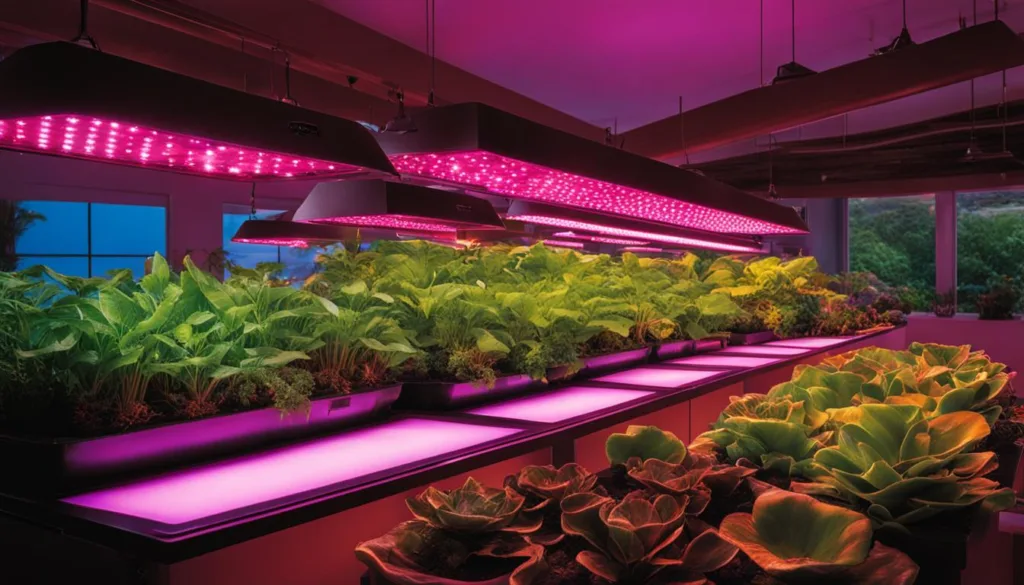
Timing is an important factor in maximizing plant growth with artificial lighting. Most plants require 12 to 16 hours of light per day, with flowering plants needing the upper end of that range.
It’s crucial to provide plants with a period of darkness as well, as they require a dark period for proper growth and respiration. Using light timers can help automate the lighting schedule and ensure consistent light exposure for your indoor plants.
Light timers allow you to set specific on and off times for your grow lights, ensuring that your plants receive the right amount of light each day. This is especially important if you’re unable to manually turn the lights on and off at the correct times.
By programming your light timers to mimic natural daylight cycles, you can create a consistent and reliable lighting schedule for your plants.
When setting up your light timers, it’s important to consider the specific light requirements of your plants. Some plants may benefit from longer periods of light, while others may require shorter intervals. It’s best to research the optimal lighting duration for your specific plant species to ensure maximum growth and health.
Benefits of Timed Lighting for Indoor Plants
- Consistency: By using light timers, you can provide a consistent lighting schedule for your plants, mimicking their natural environment and promoting healthy growth.
- Energy Efficiency: Timed lighting allows you to control the duration of light exposure, ensuring that you’re not wasting energy by leaving the lights on for longer than necessary.
- Automated Convenience: Light timers automate the process of turning the lights on and off, saving you time and effort in manually adjusting the lighting schedule.
- Plant Health: By providing your plants with the right amount of light and darkness, timed lighting helps promote proper growth, photosynthesis, and plant respiration.
| Plant Species | Optimal Lighting Duration |
|---|---|
| Leafy Greens (e.g., lettuce, spinach) | 12-16 hours of light per day |
| Herbs (e.g., basil, parsley) | 12-16 hours of light per day |
| Flowering Plants (e.g., roses, orchids) | 14-16 hours of light per day |
| Fruit-Bearing Plants (e.g., tomatoes, peppers) | 14-16 hours of light per day |
| Succulents and Cacti | 8-12 hours of light per day |
By implementing timed lighting with light timers, you can provide your indoor plants with the optimal amount of light they need to thrive. Whether you’re growing leafy greens, herbs, or flowering plants, setting a consistent lighting schedule will help ensure healthy growth and maximize the potential of your indoor garden.
Choosing the Right Light for Different Types of Plants
When it comes to indoor plants, different species have varying light requirements. Understanding the specific needs of your plants is essential in choosing the right type of light for optimal growth. Whether you have low-light plants, medium-light plants, or high-light plants, selecting the appropriate lighting setup is crucial to their overall health and well-being.
Low-Light Plants
Low-light plants, such as Chinese evergreen and snake plant, are well-suited for environments with less light. These plants can thrive in areas where natural sunlight is limited. When choosing light for low-light plants, look for options that provide a lower intensity and emit a spectrum of light suitable for their growth. Consider LED lights or fluorescent lights with a lower wattage and a spectrum that includes violet and blue light.
Medium-Light Plants
Medium-light plants, such as ferns and rubber plants, require moderate levels of light to thrive. These plants can tolerate brighter conditions than low-light plants but still require the right balance to avoid stress and damage. For medium-light plants, LED lights or fluorescent lights with a moderate intensity and a spectrum that includes a wider range of colors, including red and green light, are recommended.
High-Light Plants
High-light plants, such as citrus and hibiscus, need bright, direct light to support their growth and flowering. These plants thrive in environments with abundant sunlight. When selecting light for high-light plants, opt for options that provide a higher intensity and emit a full spectrum of light. LED grow lights or fluorescent lights with a higher wattage and a spectrum that includes all colors from violet to red are ideal for high-light plants.
By understanding the light requirements of your indoor plants, you can ensure they receive the right type of light to support their growth. Consider the specific needs of your plants and choose the appropriate lighting setup for optimal results.
| Plant Type | Light Requirements | Recommended Light Type |
|---|---|---|
| Low-Light Plants | Lower light intensity | LED lights or fluorescent lights with a lower wattage and a spectrum that includes violet and blue light |
| Medium-Light Plants | Moderate light levels | LED lights or fluorescent lights with a moderate intensity and a spectrum that includes a wider range of colors, including red and green light |
| High-Light Plants | Bright, direct light | LED grow lights or fluorescent lights with a higher wattage and a spectrum that includes all colors from violet to red |
Optimal Lighting for Popular Indoor Plants
When it comes to providing the best lighting for your indoor plants, it’s important to understand the specific light requirements of each plant species. Different plants have varying needs when it comes to light intensity, duration, and color spectrum. Here are some popular indoor plants and their optimal lighting requirements:
Spider Plant (Chlorophytum comosum)
The Spider Plant is a popular choice for indoor gardening due to its low maintenance and air-purifying capabilities. This plant thrives in bright, indirect light but can tolerate lower light conditions as well. Place your Spider Plant near a window with filtered light or use fluorescent lights if natural light is limited.
Fiddle Leaf Fig (Ficus lyrata)
The Fiddle Leaf Fig is a trendy houseplant known for its large, glossy leaves. This plant requires bright, indirect light to thrive. Place it near a window with filtered light, ensuring it receives a few hours of direct sunlight each day. If natural light is insufficient, supplement it with LED grow lights to provide the necessary light spectrum.
Pothos (Epipremnum aureum)
Pothos is a popular choice for beginners due to its low light requirements and trailing vines. This plant can tolerate a wide range of lighting conditions, from low to bright indirect light. It is a great choice for rooms with lower natural light levels or for offices with fluorescent lighting.
| Plant | Light Requirements |
|---|---|
| Spider Plant | Bright, indirect light |
| Fiddle Leaf Fig | Bright, indirect light with some direct sunlight |
| Pothos | Low to bright indirect light |
By understanding the optimal lighting requirements for popular indoor plants like Spider Plant, Fiddle Leaf Fig, and Pothos, you can ensure their growth and overall health. Remember to monitor the light levels and adjust as needed to provide the best conditions for your indoor greenery.
Tips for Setting Up Your Indoor Plant Lighting System
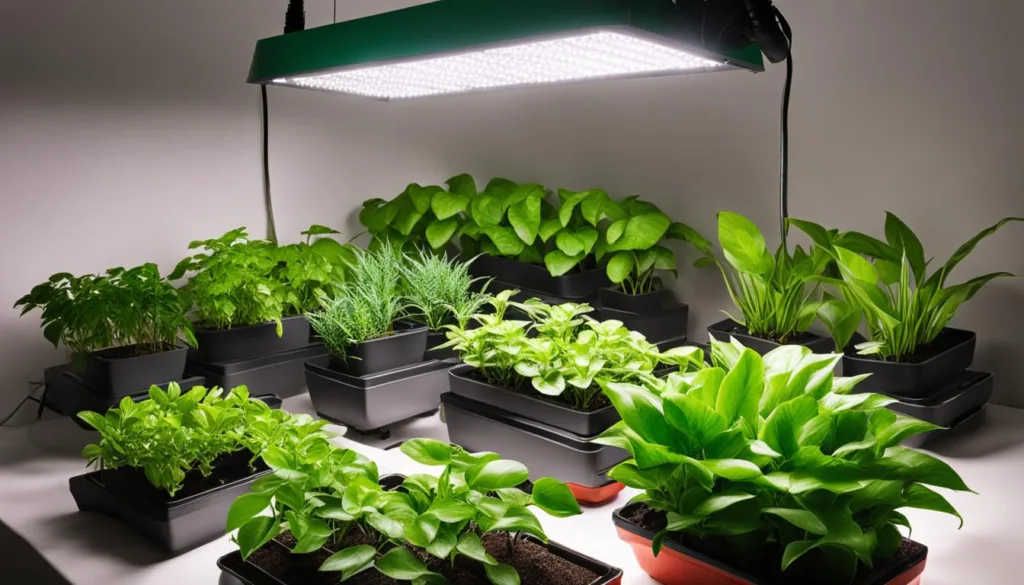
Setting up an effective indoor plant lighting system requires careful planning and consideration. By following these tips, you can ensure that your plants receive the best lighting conditions for optimal growth:
- Understand your plant’s light requirements: Different plants have varying light requirements. Some thrive in low-light conditions, while others need bright, direct light. Research the specific light needs of your plants to determine the best lighting setup.
- Choose the right type of grow lights: LED grow lights are highly recommended for indoor plants due to their energy efficiency and ability to provide a full spectrum of light. They can be programmed to adjust intensity and mimic natural sunlight. Fluorescent lights, such as T5 systems, are also a viable option. Consider the needs of your plants and select the appropriate type of grow lights.
- Position the lights correctly: Place the grow lights at an appropriate distance from your plants to ensure they receive the right amount of light. Refer to the specific light requirements of your plants for guidance. As a general rule, seedlings should be placed closer to the lights, while mature plants may require the lights to be positioned further away.
- Utilize light timers: Automation is key when it comes to providing consistent lighting for your indoor plants. Light timers can help you maintain a regular lighting schedule, ensuring that your plants receive the appropriate amount of light each day. Set the timer to provide 12 to 16 hours of light per day, depending on the needs of your plants.
By following these tips, you can create an effective indoor plant lighting system that promotes healthy growth and overall plant well-being.
Comparison of Different Types of Grow Lights
| Type of Grow Light | Advantages | Disadvantages |
|---|---|---|
| LED Grow Lights | Energy efficient, full spectrum lighting, programmable intensity | Higher initial cost |
| Fluorescent Lights (T5 systems) | Affordable, available in various spectrums, suitable for low to medium light requirements | Less intense light compared to LEDs |
| Incandescent Lights | Suitable for low-light houseplants | High heat output, not suitable for light-loving plants |
| HID (High-Intensity Discharge) Lights | Most intense light, suitable for larger spaces and plants | Higher operating costs, potential heat issues |
Remember to regularly monitor your plants’ response to the lighting system and make adjustments as needed. With proper lighting, your indoor plants can thrive and bring beauty to your space all year round.
Maximizing Indoor Plant Growth with Optimal Lighting
Providing optimal lighting conditions is crucial for maximizing the growth and overall health of indoor plants. By understanding the specific light requirements of your plants and choosing the right type of light, you can create an ideal environment for their photosynthesis and growth.
When selecting the best light for your indoor plants, consider factors such as light intensity, color spectrum, and the specific needs of your plant species. Low-light plants, like snake plants and pothos, can thrive in lower light conditions, while high-light plants, such as citrus and hibiscus, require bright lighting. Choose a light that provides a full spectrum of colors, including violet-blue for growth and red for flowering.
It’s important to pay attention to the intensity, distance, and duration of light exposure for your indoor plants. Different plants have varying light requirements, so ensure appropriate placement based on their needs.
Seedlings should be positioned 4-6 inches away from the light source and moved up as they grow. Foliage houseplants need a distance of 12-24 inches, while flowering houseplants should be placed 6-12 inches away. Regular monitoring and adjustments will help you maintain the optimal lighting conditions for your plants.
| Indoor Plant Type | Light Requirement |
|---|---|
| Snake Plant | Low Light |
| Pothos | Low Light |
| Ferns | Medium Light |
| Rubber Plant | Medium Light |
| Citrus | High Light |
| Hibiscus | High Light |
By optimizing the lighting conditions for your indoor plants, you can ensure their growth and overall well-being. The right combination of light intensity, color spectrum, and duration will promote healthy photosynthesis and encourage robust growth. Regular care and attention to your plant’s lighting needs will result in vibrant and flourishing indoor greenery.
Choosing the optimal lighting for your various indoor plants is essential for their growth and overall well-being. By understanding the different types of lighting options, considering the light requirements of your plants, and setting up a proper lighting system, you can provide the ideal conditions for your indoor greenery to thrive.
Whether you opt for LED lights, fluorescent lights, or other types of indoor plant lights, it’s crucial to consider factors such as light intensity, distance, and duration of light exposure. Monitoring and adjusting the lighting as needed will ensure consistent and optimal growth for your plants.
Remember, different plants have varying light requirements, so it’s important to choose the right light for each specific plant species.
With the right lighting, your indoor plants will not only survive but thrive, displaying vibrant foliage and potentially even blooming.
So, take the time to assess your plants’ needs, select the best light bulbs for indoor plants, and create an ideal lighting environment. By providing the necessary light for photosynthesis and growth, you can enjoy lush and healthy indoor greenery throughout the year.
FAQ
What types of lights are commonly used for indoor plants?
LED lights, incandescent lights, fluorescent lights, and halides are commonly used for indoor plants.
Which type of light is best for low-light houseplants?
Incandescent lights are suitable for low-light houseplants.
What type of light is ideal for plants with low to medium light requirements?
Fluorescent lights, especially T5 systems, are ideal for plants with low to medium light requirements.
What is the best light for light-loving plants?
LED lights are the best choice for light-loving plants due to their adjustable intensity and customizable settings.
What is the optimal distance between the light source and different types of plants?
The distance between the light source and plants varies depending on their light requirements. As a general guideline, seedlings should be placed 4-6 inches away, hydroponic lettuce and herbs need a distance of 6-12 inches, foliage houseplants require 12-24 inches, and flowering houseplants should be positioned 6-12 inches away.
How can artificial lighting compensate for limited natural light?
Artificial lights, such as LED grow lights and fluorescent lights, can provide the necessary light spectrum for photosynthesis and compensate for a lack of sunlight.
How many hours of light do most plants require per day?
Most plants require 12 to 16 hours of light per day, with flowering plants needing the upper end of that range.
Can indoor plants thrive in lower light conditions?
Yes, low-light plants, such as Chinese evergreen and snake plant, can thrive in lower light conditions.
What are some popular indoor plants and their optimal lighting requirements?
Some popular indoor plants and their optimal lighting requirements include snake plants (low light), ferns and rubber plants (medium light), and citrus and hibiscus (high light).
What should I consider when setting up an indoor plant lighting system?
When setting up an indoor plant lighting system, consider the light requirements of your plants, the intensity, distance, duration of light exposure, and the lighting conditions in your space.
How can optimal lighting maximize indoor plant growth?
Optimal lighting provides the necessary light spectrum for photosynthesis and growth, allowing indoor plants to thrive and reach their full potential.


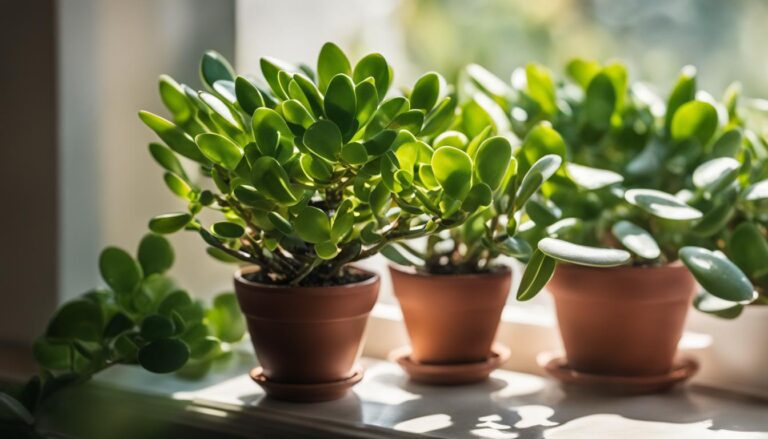
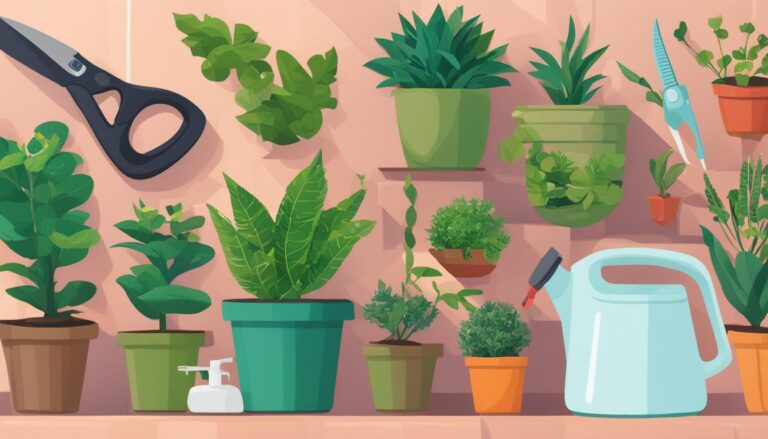
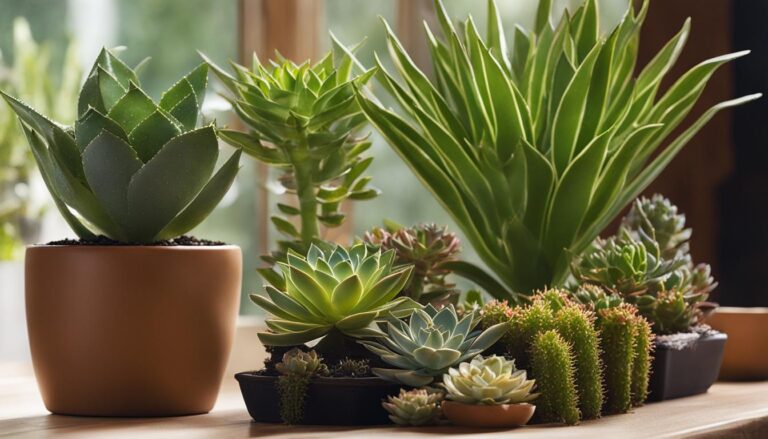
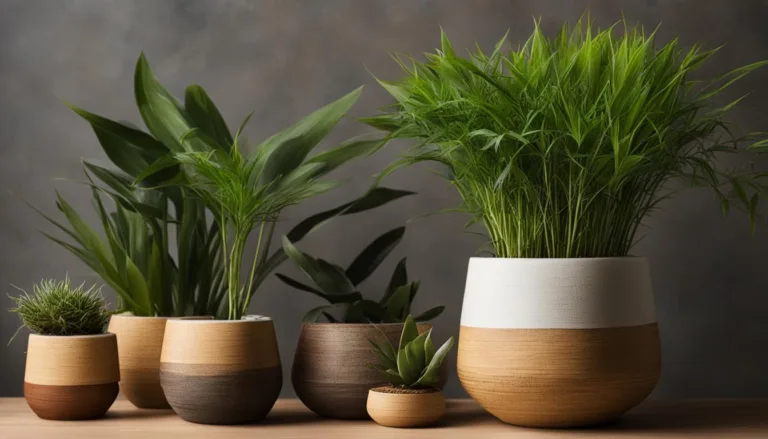
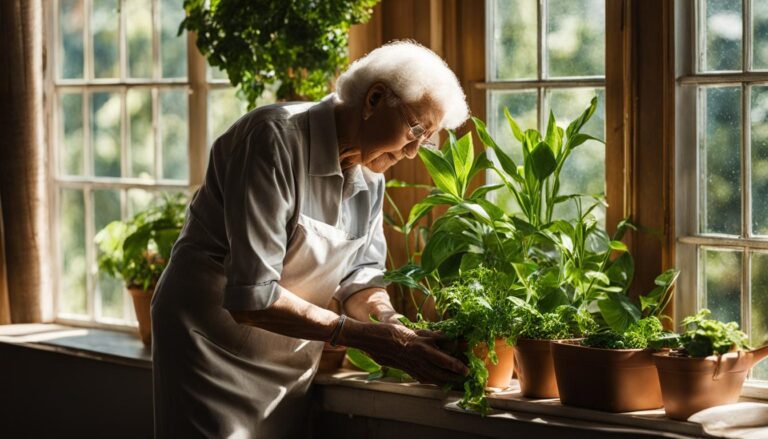
2 Comments
Comments are closed.